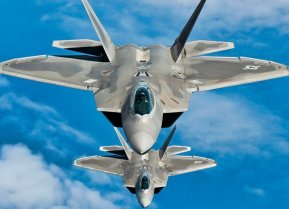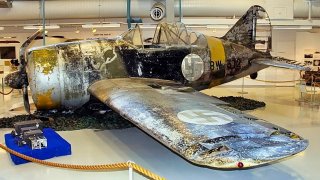Brewster Buffalo: The World War II Fighter History Can't Forget
The Brewster Buffalo, in the hands of the Finnish Air Force, was an avenging angel of death, misery, and terror.
Meet the Brewster Buffalo: The Second World War provides such a fascinating study in contrasts. The Earth-shaking conflict is replete with fighter planes that underperformed in one theater of operations yet excelled in another.
The P-38 Lightning performed fairly against the Luftwaffe in the skies over Western Europe, yet absolutely ravaged Nazi Germany’s Imperial Japanese allies in the Pacific Theater, especially in the hands of America’s all-time top two aces.
The P-39 Airacobra was lackluster at best in the hands of American pilots against the Japanese and Germans, and most Yank pilots disliked it (with Chuck Yeager being a notable exception). Yet Soviet Air Force pilots absolutely loved it and used the “Kobrushka” (little cobra) to deadly effect.
With the 81st anniversary of the Battle of Midway approaching as I type these words, this is an appropriate time to take a closer look at a warbird that was an abysmal failure at Midway yet was an absolute beast in the hands of the Finnish Air Force.
Say hello to the Brewster Buffalo.
Brewster F2A Buffalo Early History and Specifications
The Brewster F2A Buffalo made her maiden flight on Dec. 2, 1937, and entered into official operational service in April 1939. Hard to believe as this may seem, she actually beat out the Grumman F4F Wildcat in the bid to become the U.S. Navy’s first monoplane fighter. The plane was built by the Brewster Aeronautical Corporation, which was founded in 1924 and went defunct in 1946.
One of the Buffalo’s innovations was an arrestor hook geared toward carrier operations. Other specifications included a fuselage length of 26 feet 3 inches, a wingspan of 35 feet, a height of 12 feet, an empty takeoff weight of 4,732 pounds, and a maximum takeoff weight of 7,159 lbs. Max airspeed was 321 miles per hour, with a cruising speed of 161 mph. Armament consisted of two nose-mounted Browning M2 .50 caliber machine guns and two more “Ma Deuces” in the wings.
Buffalo Combat Performance Part I: Mismatched at Midway
Alas, as much as the F2A impressed the U.S. Navy back in 1937, by the time the Battle of Midway rolled around, the plane was simply outclassed by Japan’s feared Mitsubishi Zero fighter. It was unstable, and true to its animal namesake, overweight compared to the sleek and speedy Japanese plane. To reiterate what I wrote an article last year:
“If you’ll forgive a bad culinary pun here, the Zero pilots ground the Buffalo wings into Buffalo burgers. Out of the 20 USMC-flown Buffalos that responded to the Japanese bombing raid on the Midway Island installations, 13 were shot down. Repeated gun-jamming issues certainly didn’t help their cause. On a positive note, the Buffalo drivers still did manage to kill at least one Zero as well as two Aichi D3A1 ‘Val’ dive bombers.”
A harrowing account of the Buffalo drivers’ noble sacrifice is provided in the late Gordon W. Prange’s bestselling book Miracle at Midway, co-authored by Donald M. Goldstein and Katherine V. Dillon.
Buffalo Combat Performance Part Deux: Fearsome Fighter for the Finns
By sharp contrast, the Buffalo in the hands of the Finnish Air Force (Ilmavoimat) was to their Soviet Air Force adversaries what Simo Häyhä was to the Red Army ground troops: an avenging angel of death, misery, and terror.
Barrett Tillman elaborates in a September 2021 article for HistoryNet:
“To explain the difference requires strategic and tactical context…Designated Model 239s, the Finnish Brewsters were very similar to the Navy’s F2A-1 with Wright Cyclones. Despite the type’s dreadful onetime combat in U.S. service, pilots of several nations enjoyed flying it, as it was reasonably fast for the era…and had responsive controls. Finns nicknamed it Taivaan Helmi (roughly the “Sky Pearl”)… Man for man the Finns were among the world’s finest fighter pilots. Necessarily small, the Ilmavoimat sought to produce world-class aviators to oppose the nation’s most likely enemy—Russia.… ‘A major factor for good shooting results…was that every pilot was taught [by 1939] to hold their fire until within 50 meters of the target,’ Finnish historian Kari Stenman wrote. ‘After the Winter War experiences more emphasis was put on shooting skills, with known results.’”
What sort of results exactly? Thirty-six of Finland’s 96 top fighter pilots became aces in “Sky Pearls,” including six of the top 10. Yliluutnantti (“Senior Lieutenant”) Hans Wind, who was Finland's second-highest scoring overall ace with 75 total career air-to-air kills, was the world's top ace in a Buffalo, bagging 39 of his victories in the ungainly fighter.
One particular unit, Air Squadron 24, claimed 477 victories for the loss of 19 in combat and six more in accidents or destroyed on the ground between 1941 and 1944, for an astonishing 25:1 kill ratio.
Where Are They Now?
Out of 509 total Buffalos built, only one bona fide survivor exists, that being a Finnish B-239 bearing serial number BW-372, flown during the war by Lt. Lauri Pekuri, now on display at the Keski-Suomen Ilmailumuseo, the Finnish Air Force Museum. For the benefit of our stateside readers who lack the time or money to book a trip to Finland, there is a full-scale replica at the Cradle of Aviation Museum in Long Island, New York.
For you plastic model-building enthusiasts out there, some of your choices include a Tamiya 1:48 scale and a Hobby Boss 1:72 scale kit.
About the Author
Christian D. Orr is a former U.S. Air Force Security Forces officer, Federal law enforcement officer, and private military contractor (with assignments worked in Iraq, the United Arab Emirates, Kosovo, Japan, Germany, and the Pentagon). Chris holds a B.A. in International Relations from the University of Southern California (USC) and an M.A. in Intelligence Studies (concentration in Terrorism Studies) from American Military University (AMU). He has also been published in The Daily Torch and The Journal of Intelligence and Cyber Security. Last but not least, he is a Companion of the Order of the Naval Order of the United States (NOUS).
All images are Creative Commons.


